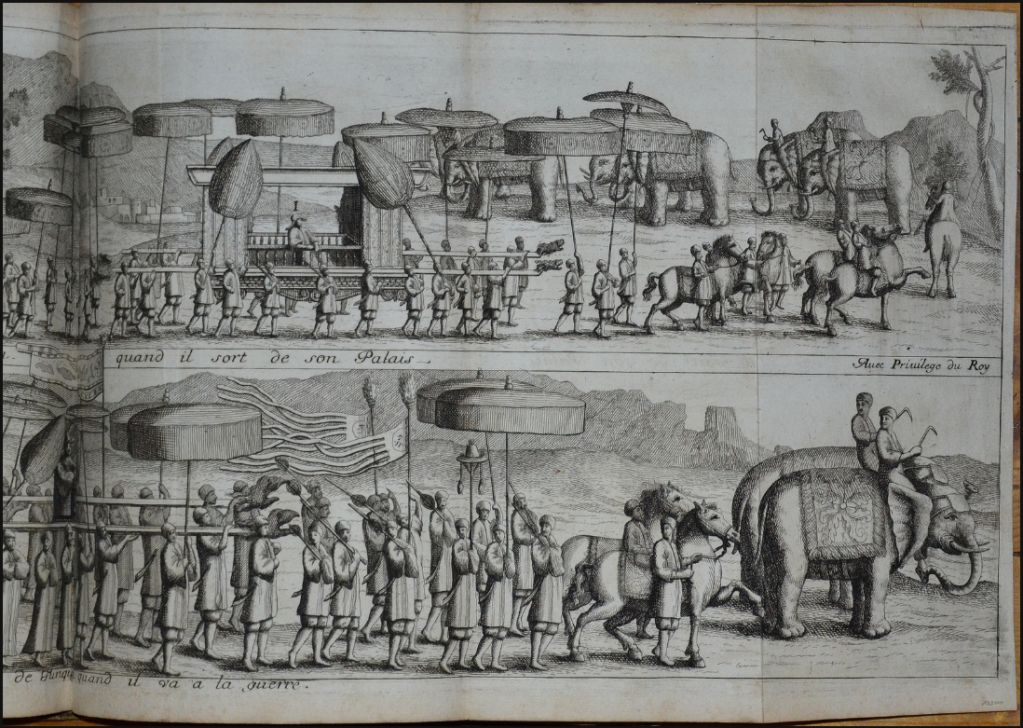Descriptions of the Kingdom of Tonkin-an account by Samuel Baron
Only a few of the poorer people will attend to strangers, or are forced otherwise for a livelihoo. He notes how the Tonqueenese were ravished with admiration, when he showed them his Atlas, and maps and structure of the world.
Tonqueenese are much degenerated, yet it cannot be denied, but the strangers at the first entrance into this country, had, in many respects, better usage than at present; but not so, as to permit themselves to play with a foreigner the good companion, at this time they keep their distance to all strangers, making but small account with them. (So in comparison to the Cochin-Chineses the Tonquenese were not as welcoming and warm towards outsider, they were more careful and suspicious, and less giving)
This country is for the most part low and flat, not unlike the united provinces , especially for its moats and banks. To the north-east of this kingdom lies the province of Canton; to the west it is bounded by the kingdom of Laos and Bowes; to the north it borders on two other provinces of China, Yunnan and Guangxi, and to the south and south-east is Cochin-China. This country is very temperate due to the many rivers and rain that generally fall in the months of May, June, July and August, which moistens the ground but cause no fresh breezes at all; on the contrary, July and August is insufferably hot. The climate is temperate and wholesome, from September until March, and sometime very cold in January and February; though frost and snow are never seen. The country would be plentiful in fruits, were there not so many inhabitants, who live by rice chiefly, finding greater necessity to cultivate what ground they have with that grain. There are rivers that are swarm with bots and large barks, which make it very commodious for traders: indeed in this country grows neither corn nor whine, which is not occasioned by the want of rains, for both of them require rather dry than wet ground; but by reason the inhabitants do not much care for them, as being ignorant of their goodness, and therefore do not plant them. This kingdom is not much bigger than Portugal, but four times the number in population. There are several islands in the bay of Tonqueen in which ships may pass.
Towards the north-west is a fair bay; where many fishing boats and fisherman reside. In this island is the watch-house general; which is a place fo the greatest profit in the kingdom of Tonqueen: for all trading boats, either to the province of Thanh Hoa or Nghe An, or from the north who must stop here to pay custom, for a large boat about half of the value of a dollar and a half, with some presents for the waiters, the rest proportional; so that the customs of this place cannot yield less than a million of dollars per annum.
As for the ground, it is stony and mountainous, therefore not proper to manure; cattle we saw but few so that rice and other provisions for sustenance, are brought hither from adjacent shore. Some good regulations would make this place plentiful, and with small expense this port may be a good one.
There are only 2-3 marketplaces in the whole kingdom. The Ca-Cho or marketplace is the metropolis of Tonqueen; it is superior to most cities in Asia due to it is populousness; On the first and fifteen of the month, adjacent villages flock together to trade; thus, several of those streets though broad and spacious, are then so crowded that one finds enough to do if he can sometimes advance through the multitude a hundred paces in half an hour. Every different commodity sold in this city is appointed to a particular street, and these streets again allotted to one, two, or m ore villages, the inhabitants whereof are only privileged to keep shops in them, much in the nature of the several companies or corporations in European cities. The courts of the king, general, princes and etc, and high courts of justice are located here. They stand on large tracts of ground; the principal structure makes but a mean appearance, being built of wood, the rest of their houses of bamboos and clay, not well compacted; few of brick except the factories of strangers, which out-vie the rest. Stupendous, indeed, are the triple walls of the old city and palace; for by the ruins they appear to have been strong materials with noble large gates, paved with a king of marbles; the palace have to been about six to seven miles in circumferences; its gates, courts, apartments, testify amply its former pomp and glory. In this city is a quartered militia, to be ready on all occasions; and here is also the king's arsenal for war, seated on the bank of the river, near a sandy island, on which the Thecadaw is kept. The river is called Song Cai or Song Hong (Red River). This river is a exceeding commodious for the city, since all sorts of merchandises are brought hither as to epitome of the kingdom, by an infinite number of boats trading up and down the country; yet they have their houses in their respective Aldeas, and do not live together in their boats as Taverniere reports, but when they are voyaging. (Many of the people choose to live upon the water rather than the land, the rivers are covered with boats that serve as houses, which are very neat and cattle are kept in them).
^^ The city of Cha-Cho (marketplace), the Metropolis of Tonqueen. 1) The King's Aresnal. 2) Sandy Bay Island with the Representation of the Theckydaw. 3)King's Elephant's Stables. 4) The designed English Factory. 5) The Dutch Factory.

